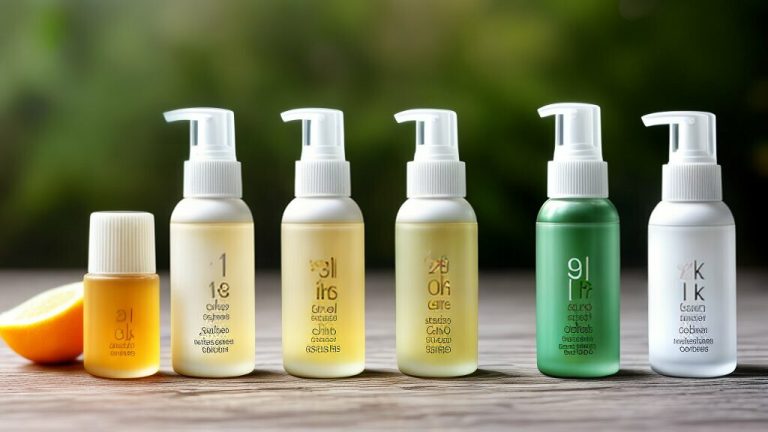How to Use Serum: Expert Tips for a Glowing Skincare Routine
A serum is an essential part for any skincare routine, this helps provide numerous benefits for the skin. If you’re new to using serum or looking to improve your application techniques, you’ve come to the right place. In this section, we will provide an overview of serum and its benefits for the skin. We will also discuss different techniques for applying serum effectively.
The serum is a lightweight, fast-absorbing skincare product that contains highly concentrated active ingredients. Unlike traditional moisturizers, serums penetrate deep into the skin to address specific concerns, such as wrinkles, dark spots, and uneven texture. By adding a suitable serum to your routine, you can amplify the benefits of your other skincare products and achieve a radiant and youthful complexion.
Key Takeaways:
- A specific serum is an essential part of any skincare routine.
- Serums contain highly concentrated active ingredients.
- Serums penetrate deep into the skin to address specific concerns.
- Serums amplify the benefits of other skincare products.
Understanding Serum and Its Benefits
Serums are lightweight skincare products designed to penetrate the skin deeply and deliver an intense dose of active ingredients. Unlike other skincare products, such as moisturizers or toners, serums are formulated with more active ingredients, making them more potent and effective in addressing specific skincare concerns.
One of the most significant benefits of using a serum is that it can help to target specific skin concerns on skin like fine lines, wrinkles dark spots, and also help to fade uneven skin tone. Depending on the formulation, serums can contain various ingredients, including antioxidants, peptides, hyaluronic acid, and vitamin C, which works together to improve skin health and appearance.
In addition to its targeted benefits, serum can also help to improve overall skin hydration and texture. Many serums are formulated with ingredients which boosts collagen production, improving skin elasticity and firmness.
How are Serums Different from Other Skincare Products?
Serums differ from other skincare products, such as moisturizers or toners, in a few key ways. First and foremost, serums contain a much higher concentration of active ingredients. This means they are more effective at targeting specific skin concerns and delivering visible results.
Additionally, serums are designed to be applied on a clean skin but before applying a moisturizers. This process will allow the active ingredients in the serum to pierce deep into the skin without any barriers from other products.
Overall, adding a serum to your skincare routine can help address specific skin concerns while improving overall skin health and appearance. With so many different formulations available, choosing a serum tailored to your individual needs and skin type is important.
Choosing the Right Serum for Your Skin Type
When selecting a serum, it is essential to consider your skin type. Different serums target different concerns, so choosing the right one for you will maximize the benefits. Here are some tips to help you select the appropriate serum:
| Step | Instructions |
|---|---|
| Step 1 | Identify your skin concerns. Do you struggle with dry skin, oily skin, or a combination of both? Are you looking to target fine lines and wrinkles, or do you want to brighten your complexion? Understanding your skin needs will help you choose the right serum. |
| Step 2 | Consider the ingredients. Look for ingredients that address your specific concerns. For example, if you have dry skin, look for a serum containing hyaluronic acid, which helps hydrate and plump the skin. |
| Step 3 | Check the concentration levels. A higher concentration of active ingredients will provide more noticeable results, but it may not be suitable for sensitive skin. |
| Step 4 | Be aware of potential sensitivities. Some serums may contain ingredients that can cause irritation or allergic reactions. Patch test a small area before using a new serum on your face. |
Following these guidelines will help ensure you choose a serum that is right for your skin type and will provide the desired results.
Preparing Your Skin for Serum Application
Before applying serum, it is essential to prepare your skin properly. By following these steps, you can maximize the serum’s effectiveness and ensure it is fully absorbed into your skin.
Cleansing
Always start by washing your face with a cleanser specifically suitable for your skin type. This will remove impurities, excess oil, and makeup from your skin. Starting with a clean slate allows the serum to penetrate your skin and deliver its active ingredients more effectively. Dry your skin with a clean towel, avoiding harsh rubbing or tugging that can damage your skin.
Toning
Next, you can apply a toner to your skin. This step balances your skin’s pH and helps restore any lost hydration. Apply the toner to a cotton or a cotton pad and patt gently over your face, avoiding the eye area. This step will help the skin to prepare for the serum and ensures it can penetrate deeper into your skin.
Exfoliation
Exfoliation is the main process of removal of dead skin cells from the surface of your skin. This step helps to unclog pores, improve skin texture, and enhance serum absorption. You can use a physical (scrub) or chemical (exfoliating acids) exfoliant. It’s crucial to avoid over-exfoliating, which can damage the skin. Limit your exfoliation to 2-3 times per week, depending on your skin type and sensitivity.
By following these common steps, you can prepare your skin for the serum application and ensure that the serum can sink deeper into your skin for maximum results.
Applying Serum: Techniques for Maximum Absorption
Now that you have selected the suitable serum for your skin type and prepared your skin accordingly, it’s time to apply your serum effectively. Follow these techniques for maximum absorption:
- Patting: Use your fingertips to gently pat the serum onto your skin, starting from the center and working outward. This technique is ideal for thinner serums that absorb quickly.
- Pressing: Apply a small amount of serum to your palms, rub them together, and press the serum into your skin. This technique is ideal for thicker serums that require more time to absorb.
- Massaging: Use circular motions to massage the serum into your skin, starting from the center and working outward. This technique is ideal for serums that require deeper penetration, such as anti-aging serums.
Remember to always be gentle and avoid tugging or pulling on your skin. Allow a few minutes for the serum to fully absorb before applying any additional products, such as moisturizer or sunscreen.
Incorporating Serum into Your Skincare Routine
Including a serum to your daily skincare routine will help to enhance the health and appearance of your skin. Here are some guidelines to help you incorporate a serum into your regimen:
When to Apply Serum
Serums can be applied both in the morning or evening after using a cleanser and toner. In the morning, it is best to apply the serum before sunscreen, and in the evening, after any treatments that you might use, such as retinol or AHA/BHA exfoliants.
Layering with Other Products
Serum can be used alone or with other products, depending on your needs and preferences. If you have dry skin, layer a moisturizer on your serum. If you are someone who has oily skin, consider using a lightweight moisturizer or skip it altogether. In any case, wait a few minutes between applying serum and any additional products.
Amount of Serum to Use
The amount of serum you should use depends on the product’s concentration and your skin’s needs. Generally, you should use a pea-sized amount for your face and neck and a little more if you are also applying it to your chest or hands. Be careful not to over-apply serum, as it can lead to pilling or a greasy feel.
Frequency of Serum Use
How often you should use serum depends on your skin type, age, and other factors. As a starting point, you can use the serum once daily, either in the morning or evening. If you have oily or acne-prone skin, use it twice a day. If you have sensitive skin, start with a few times a week and gradually increase the frequency as your skin adjusts.
- Keep in mind that consistency is key when it comes to seeing results from serum.
- Pay attention to how your skin responds to serum and adjust the frequency and amount of use accordingly.
Understanding the Dosage and Frequency of Serum Use
When applying serum, it’s essential to get the dosage and frequency just right. Too little serum and you won’t see the desired results, while too much serum can irritate the skin. Here are some general guidelines to help you use serum effectively:
- If you’re new to using serum, start with a small amount, about a pea-sized drop, and gradually increase the amount as your skin adjusts to the product.
- Serum should be applied twice daily, once in the morning and once at night, to get the best results. However, you can always adjust the frequency according to your skin’s needs.
- If you have sensitive skin, use the serum every other day until your skin adjusts to the product. You can then increase usage to once a day.
- When applying serum, be gentle and avoid rubbing too hard, as this can irritate the skin.
- Always follow the instructions provided by the serum manufacturer, and if you have any concerns, consult a dermatologist.
Remember, using serum is just one part of a comprehensive skincare routine. Combining the serum with other skincare products, such as cleansers, toners, and moisturizers, is essential for maximum benefits. With the correct dosage and frequency, serum will help you to achieve a radiant and youthful complexion.
Troubleshooting Common Serum Application Issues
Although using serum may seem straightforward, people need help with applying it. Here are some tips to help you troubleshoot these problems:
Pilling
Pilling is when the serum balls up on the skin, preventing it from being absorbed properly. Make sure your skin is clean and dry before applying serum to avoid this. Let your skin to absorb product thoroughly before using moisturizer or applying makeup.
Uneven Absorption
Uneven absorption can occur when the serum is not applied evenly or when the skin is not appropriately prepped. Apply the serum in small dots across your face and neck to ensure even absorption, and gently pat it using your fingertips.
Compatibility with Other Skincare Products
When using serum, it’s essential to ensure it’s compatible with other skincare products you may be using. To avoid any negative reactions, always read the instructions on your skincare products and research the ingredients to ensure there are no known incompatibilities.
Additionally, waiting a few minutes after applying the serum before layering on other products like moisturizers and sunscreens is a good idea to ensure maximum absorption.
By following these tips, you can avoid common serum application issues and achieve the desired results for your skin.
Conclusion
Incorporating serum into your skincare routine is an effective way to achieve glowing and youthful skin. By understanding the benefits of a serum, choosing the right product for your skin type, preparing your skin before application, and using effective techniques for maximum absorption, you can optimize the benefits of this powerful skincare product. Remember to follow general guidelines for dosage and frequency and troubleshoot any issues that may arise.
With these tips in mind, you can expect to see visible improvements in your skin’s texture, tone, and overall health. Remember to consult with a skincare professional if you have any specific concerns or questions about your skincare routine.

I’m Carol Edwards, the force behind SerumDeals.com – your one-stop for all things serum. With over a decade of obsessing over skincare, I’m here to demystify sensational skin. I dig deep, testing serums in action. Beyond the surface, I uncover actual effectiveness. From ingredient breakdowns to real-life testing, my reviews are your trustworthy guide. Whether you’re a skincare rookie or diving into specifics like anti-aging or hydration, I’ve got your back with accurate info. Let’s simplify the serum journey together. SerumDeals.com isn’t just a site; it’s a hub for thriving skincare aficionados. Join me to uncover vibrant skin, one serum at a time.
Glowingly, Carol Edwards






